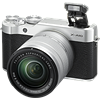Main
Model
Price
Advantages
launch
Announced
Body type
Camera subcategory
Sensor
Effective pixels
Max resolution
Sensor size
Sensor type
Processor
Image ratio w:h
Other resolutions
Sensor photo detectors
Image
ISO
Boosted ISO (minimum)
Boosted ISO (maximum)
White balance presets
Custom white balance
Image stabilization
Uncompressed format
JPEG quality levels
Image stabilization notes
Photography features
Minimum shutter speed
Maximum shutter speed
Maximum shutter speed (electronic)
Aperture priority
Shutter priority
Manual exposure mode
Subject / scene modes
Built-in flash
Flash range
External flash
Flash modes
Continuous drive
Self-timer
Metering modes
Exposure compensation
AE Bracketing
WB Bracketing
Screen / viewfinder
Articulated LCD
Screen size
Screen dots
Touch screen
Screen type
Live view
Viewfinder type
Viewfinder coverage
Viewfinder magnification
Viewfinder resolution
Videography features
File Format
Microphone
Speaker
Optics & Focus
Autofocus
Manual focus
Number of focus points
Lens mount
Focal length multiplier
Physical
Weight (inc. batteries)
Dimensions
Environmentally sealed
Battery
Battery details
Battery Life (CIPA)
Storage
Storage types
Connectivity
USB
HDMI
Microphone port
Headphone port
Wireless
Wireless notes
Remote control
Other features
Orientation sensor
Timelapse recording
GPS
Samples
Videos
Summary
The Sony Alpha a9 highest resolution of 6000 x 4000 pixels (24 megapixels) is better than the Fujifilm X-A10 highest resolution of 4896 x 3264 pixels (16 megapixels). The Sony Alpha a9 is produced with larger sensor than the Fujifilm X-A10: Full frame (35.6 x 23.8 mm) versus APS-C (23.6 x 15.6 mm). It is the most significant difference between these cameras as big sensor lets the photographer to take pictures of the more professional quality. The Sony Alpha a9 offers a wider ISO range of 100-51200 in compare with 200-6400 ISO range of the Fujifilm X-A10. This ISO numbers let the camera owner to take better pictures in low light situations. The Sony Alpha a9 has more number of white balance presets - 10. It gives the photographer more control over colour. The Sony Alpha a9 provides image stabilization that will help the photographer to take clearer pictures of non-moving subjects in low light when you are not using the flash. The Sony Alpha a9 offers more focus points in compare with the Fujifilm X-A10: 693 vs 49. More focus points means more convenience when attempting to focus on objects that are not centred.
The Sony Alpha a9 display is better as it has more screen dots 1,440,000 in comparison to 1,040,000 dots of the Fujifilm X-A10 display. The higher dot count display is better for reviewing photos on your camera. The Alpha a9 is equipped with a touch screen.
The Fujifilm X-A10 is equipped with built-in flash. The Alpha a9 supports external flash. It provides amazing control over the exposure and lighting of the subject in low light and in bright light situations where you need to fill-flash. The Sony Alpha a9 battery life is better in compare to the Fujifilm X-A10 battery life. In accordance with CIPA standards the photographer will be able to capture 650 shots with the Alpha a9 and only 410 with the X-A10. The X-A10 weighs 331g that is 342g lighter than the weight of the Alpha a9.
Taking into account the above differences the Sony Alpha a9 will become the best choice. Get the list of the best offers on Amazon.


